2014 SUBARU TRIBECA belt
[x] Cancel search: beltPage 62 of 426
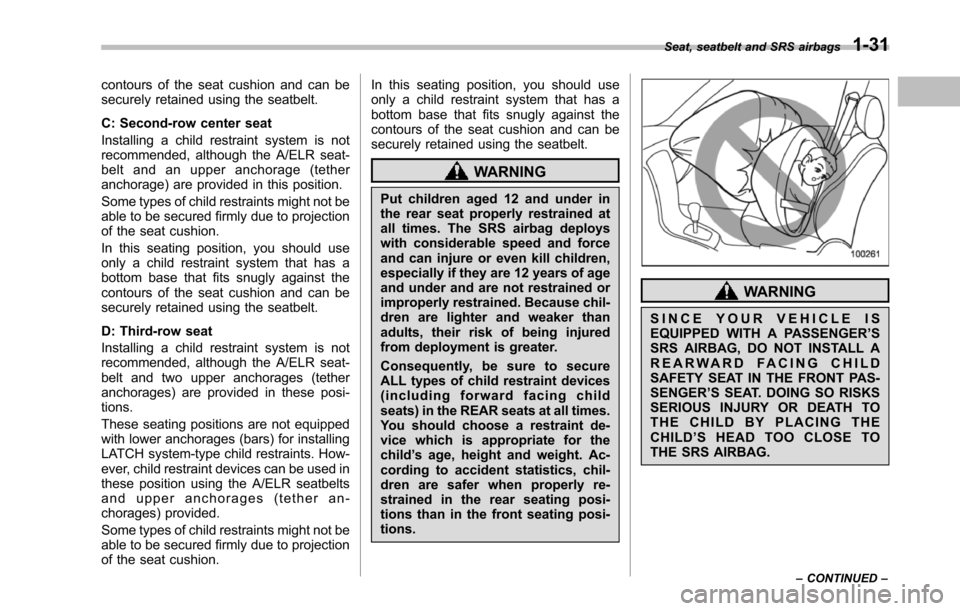
contours of the seat cushion and can besecurely retained using the seatbelt.
C: Second-row center seat
Installing a child restraint system is notrecommended, although the A/ELR seat-belt and an upper anchorage (tetheranchorage) are provided in this position.
Some types of child restraints might not beable to be secured firmly due to projectionof the seat cushion.
In this seating position, you should useonly a child restraint system that has abottom base that fits snugly against thecontours of the seat cushion and can besecurelyretained using the seatbelt.
D: Third-row seat
Installing a child restraint system is notrecommended, although the A/ELR seat-belt and two upper anchorages (tetheranchorages)are provided in these posi-tions.
These seating positions are not equippedwith lower anchorages (bars) for installingLATCH system-type child restraints. How-ever, child restraint devices can be used inthese position using the A/ELR seatbeltsand upper anchorages (tether an-chorages) provided.
Some typesof child restraints might not beable to be secured firmly due to projectionof the seat cushion.
In this seating position, you should useonly a child restraint system that has abottom base that fits snugly against thecontours of the seat cushion and can besecurely retained using the seatbelt.
WARNING
Put children aged 12 and under inthe rear seat properly restrained atalltimes. The SRS airbag deployswith considerable speed and forceand can injure or even kill children,especially if they are 12 years of ageand under and are not restrained orimproperly restrained. Because chil-dren are lighter and weaker thanadults, their risk of being injuredfrom deployment is greater.
Consequently, be sure to secureALL types of child restraint devices(including forward facing childseats) in the REAR seats at all times.You should choose a restraint de-vice which is appropriate for thechild’s age, height and weight. Ac-cording to accident statistics, chil-dren are safer when properly re-strained in the rear seating posi-tions than in the front seating posi-tions.
WARNING
SINCE YOUR VEHICLE ISEQUIPPED WITH A PASSENGER’SSRS AIRBAG, DO NOT INSTALL AREARWARD FACING CHILDSAFETY SEAT IN THE FRONT PAS-SENGER’S SEAT. DOING SO RISKSSERIOUS INJURY OR DEATH TOTHE CHILD BY PLACING THECHILD’SHEADTOOCLOSETOTHE SRS AIRBAG.
Seat, seatbelt and SRS airbags1-31
–CONTINUED–
Page 63 of 426
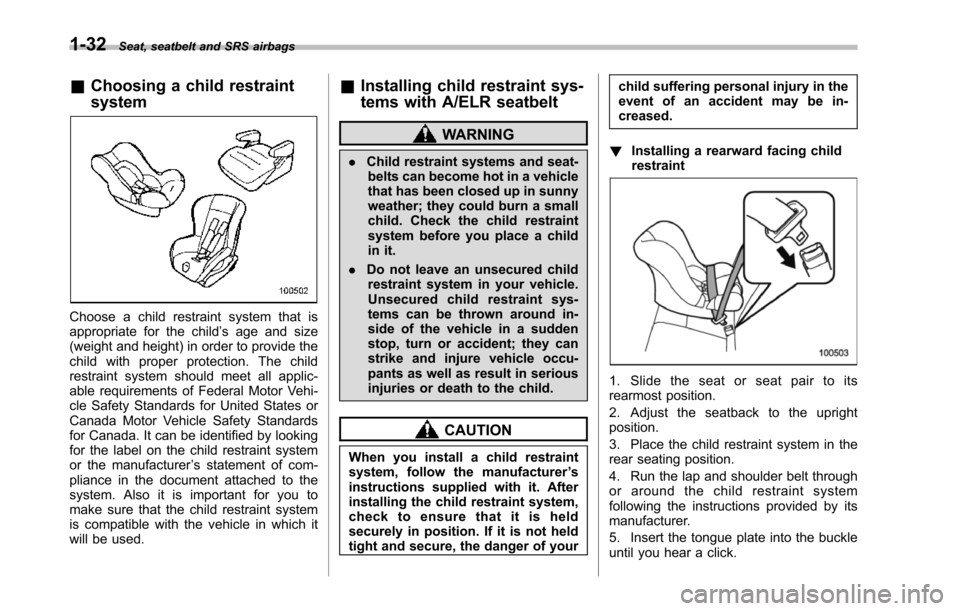
1-32Seat, seatbelt and SRS airbags
&Choosing a child restraint
system
Choose a child restraint system that isappropriate for the child’s age and size(weight and height) in order to provide thechild with proper protection. The childrestraint system should meet all applic-able requirements of Federal Motor Vehi-cle Safety Standards for United States orCanada Motor Vehicle Safety Standardsfor Canada. It can be identified by lookingfor the label on the child restraint systemor the manufacturer’s statement of com-pliance in the document attached to thesystem. Also it is important for you tomake sure thatthe child restraint systemis compatible with the vehicle in which itwill be used.
&Installing child restraint sys-
tems with A/ELR seatbelt
WARNING
.Child restraint systems and seat-belts can become hot in a vehiclethat has been closed up in sunnyweather; they could burn a smallchild. Check the child restraintsystem before you place a childin it.
.Do not leave an unsecured childrestraint system in your vehicle.Unsecured child restraint sys-tems can be thrown around in-side of the vehicle in a suddenstop, turn or accident; they canstrikeand injure vehicle occu-pants as well as result in seriousinjuries or death to the child.
CAUTION
When you install a child restraintsystem, follow the manufacturer’sinstructions supplied with it. Afterinstalling the child restraint system,check to ensure that it is heldsecurely in position. If it is not heldtight and secure, the danger of your
child suffering personal injury in theevent of an accident may be in-creased.
!Installing a rearward facing childrestraint
1. Slide the seat or seat pair to itsrearmost position.
2. Adjust the seatback to the uprightposition.
3. Place the child restraint system in therear seating position.
4. Run the lap and shoulder belt throughor around the child restraint systemfollowing the instructions provided by itsmanufacturer.
5. Insert the tongue plate into the buckleuntil you hear a click.
Page 64 of 426

6. Take up the slack in the lap belt.
7. Pull out the seatbelt fully from theretractor to change the retractor over fromthe Emergency Locking Retractor (ELR)to the Automatic Locking Retractor (ALR)mode. Then, allow the belt to rewind intothe retractor. As the belt is rewinding,clicks will be heard which indicate theretractor functions as ALR.
8. Push and pull the child restraintsystem forward and from side to side tocheck if it is firmly secured.
Sometimes a child restraint can be morefirmlysecured by pushing it down into theseat cushion and then tightening theseatbelt.
9. Pull at the shoulder portion of the beltto confirm that it cannot be pulled out (ALRproperly functioning).
10. To remove the child restraint system,press the release button on the seatbeltbuckle and allow the belt to retractcompletely. The belt will return to theELR mode.
WARNING
NEVER INSTALL A REARWARD FA-CING CHILD SEAT IN THE FRONTPA S S E N G E R’SSEAT.DOINGSORISKS SERIOUS INJURY OR DEATHTO THE CHILD BY PLACING THECHILD’S HEAD TOO CLOSE TO THESRS AIRBAG.
Seat, seatbelt and SRS airbags1-33
–CONTINUED–
Page 65 of 426

1-34Seat, seatbelt and SRS airbags
NOTE
When the child restraint system is nolonger in use, remove it and restore theELR mode of the retractor. That modeis restored by retracting the seatbeltfully.
!Installingforward facing child re-straint
Second-row outboard seat1) Head restraint2) Release button
Second-row center seat1) Head restraint2) Release button
Third-row seat1) Head restraint2) Lowering strap
1. When installing on thesecond-rowoutboard seat, remove the head restraint.When installing on thesecond-row cen-ter seat, raise the head restraint. Wheninstalling on thethird-row seat, lower thehead restraint.
2. Slide the seat or seat pair to itsrearmost position.
3. Adjust the seatback to the uprightposition.
4. Place the child restraint system in theseatingposition.
5. Run the lap and shoulder belt throughor around the child restraint systemfollowing the instructions provided by itsmanufacturer.
6. Insert the tongue plate into the buckleuntil you hear a click.
Page 66 of 426
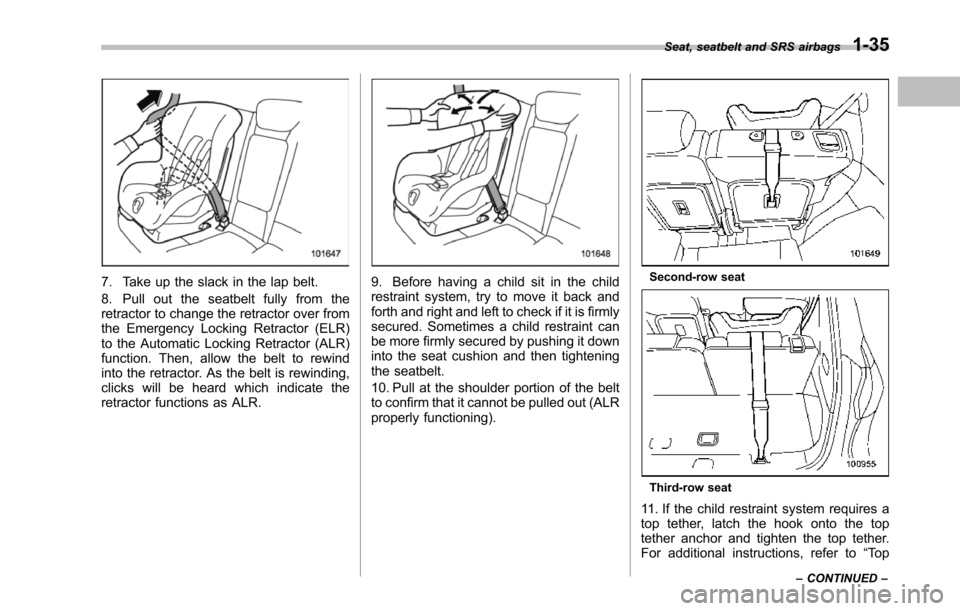
7. Take up the slack in the lap belt.
8. Pull out the seatbelt fully from theretractor to change the retractor over fromthe Emergency Locking Retractor (ELR)to the Automatic Locking Retractor (ALR)function. Then, allow the belt to rewindinto the retractor. As the belt is rewinding,clicks will be heard which indicate theretractor functions as ALR.
9. Before having a child sit in the childrestraint system, try to move it back andforth and right and left to check if it is firmlysecured. Sometimes a child restraint canbe more firmly secured by pushing it downinto the seat cushion and then tighteningtheseatbelt.
10. Pull at the shoulder portion of the beltto confirm that it cannot be pulled out (ALRproperly functioning).
Second-row seat
Third-row seat
11. If the child restraint system requires atop tether, latch the hook onto the toptether anchor and tighten the top tether.For additional instructions, refer to“To p
Seat, seatbelt and SRS airbags1-35
–CONTINUED–
Page 67 of 426
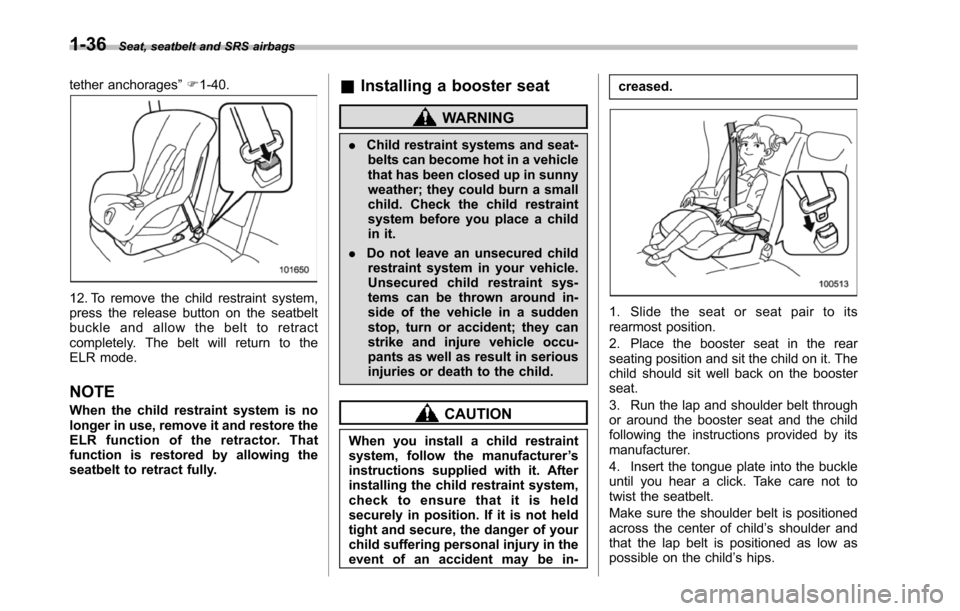
1-36Seat, seatbelt and SRS airbags
tether anchorages”F1-40.
12. To remove the child restraint system,press the release button on the seatbeltbuckle and allow the belt to retractcompletely. The belt will return to theELR mode.
NOTE
When the child restraint system is nolonger in use, remove it and restore theELR function of the retractor. Thatfunction is restored by allowing theseatbelt to retract fully.
&Installing a booster seat
WARNING
.Child restraint systems and seat-belts can become hot in a vehiclethat has been closed up in sunnyweather; they could burn a smallchild. Check the child restraintsystem before you place a childin it.
.Do not leave an unsecured childrestraint system in your vehicle.Unsecured child restraint sys-tems can be thrown around in-side of the vehicle in a suddenstop, turn or accident; they canstrike and injure vehicle occu-pants as well as result in seriousinjuriesor death to the child.
CAUTION
When you install a child restraintsystem, follow the manufacturer’sinstructions supplied with it. Afterinstalling the child restraint system,check to ensure that it is heldsecurely in position. If it is not heldtight and secure, the danger of yourchild suffering personal injury in theevent of an accident may be in-
creased.
1. Slide the seat or seat pair to itsrearmost position.
2. Place the booster seat in the rearseating position and sit the child on it. Thechild should sit well back on the boosterseat.
3. Run the lap and shoulder belt throughor around the booster seat and the childfollowing the instructions provided by itsmanufacturer.
4. Insert the tongue plate into the buckleuntil you hear a click. Take care not totwist the seatbelt.
Make sure the shoulder belt is positionedacross the center of child’s shoulder andthat the lap belt is positioned as low aspossible on the child’s hips.
Page 68 of 426
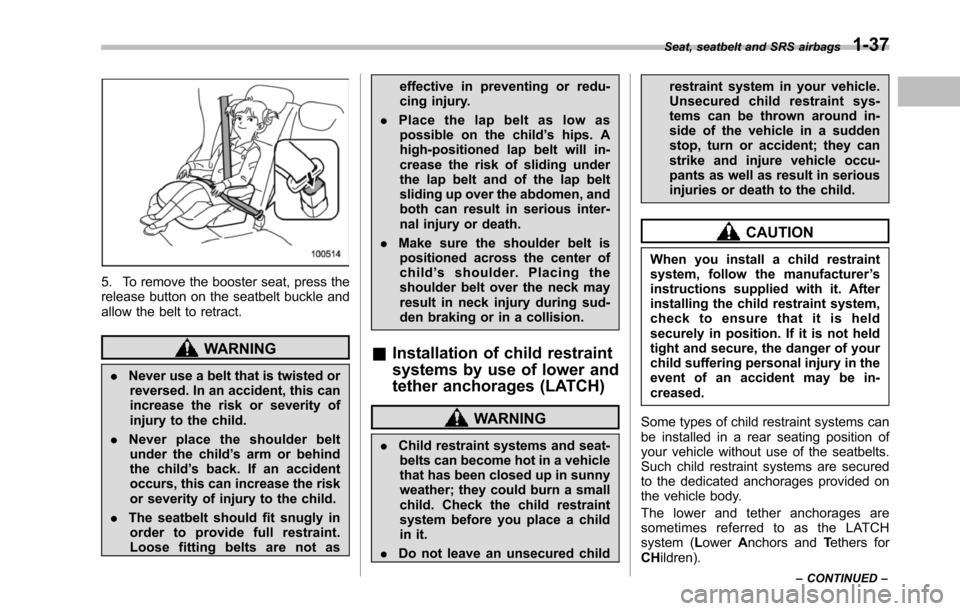
5. To remove the booster seat, press therelease button on the seatbelt buckle andallow the belt to retract.
WARNING
.Never use a belt that is twisted orreversed.In an accident, this canincrease the risk or severity ofinjury to the child.
.Never place the shoulder beltunder the child’s arm or behindthe child’s back. If an accidentoccurs, this can increase the riskor severity of injury to the child.
.The seatbelt should fit snugly inorder to provide full restraint.Loose fitting belts are not as
effective in preventing or redu-cing injury.
.Place the lap belt as low aspossible on the child’s hips. Ahigh-positioned lap belt will in-crease the risk of sliding underthe lap belt and of the lap beltsliding up over the abdomen, andboth can result in serious inter-nalinjury or death.
.Make sure the shoulder belt ispositioned across the center ofchild’sshoulder.Placingtheshoulder belt over the neck mayresult in neck injury during sud-den braking or in a collision.
&Installation of child restraint
systems by use of lower and
tether anchorages (LATCH)
WARNING
.Child restraint systems and seat-belts can become hot in a vehiclethat has been closed up in sunnyweather; they could burn a smallchild.Check the child restraintsystem before you place a childin it.
.Do not leave an unsecured child
restraint system in your vehicle.Unsecured child restraint sys-tems can be thrown around in-side of the vehicle in a suddenstop, turn or accident; they canstrike and injure vehicle occu-pants as well as result in seriousinjuries or death to the child.
CAUTION
When you install a child restraintsystem, follow the manufacturer’sinstructions supplied with it. Afterinstalling thechild restraint system,check to ensure that it is heldsecurely in position. If it is not heldtight and secure, the danger of yourchild suffering personal injury in theevent of an accident may be in-creased.
Some types of child restraint systems canbe installed in a rear seating position ofyour vehicle without use of the seatbelts.Such child restraint systems are securedto the dedicated anchorages provided onthe vehicle body.
The lower and tether anchorages aresometimes referred to as the LATCHsystem (LowerAnchors andTethers forCHildren).
Seat, seatbelt and SRS airbags1-37
–CONTINUED–
Page 69 of 426
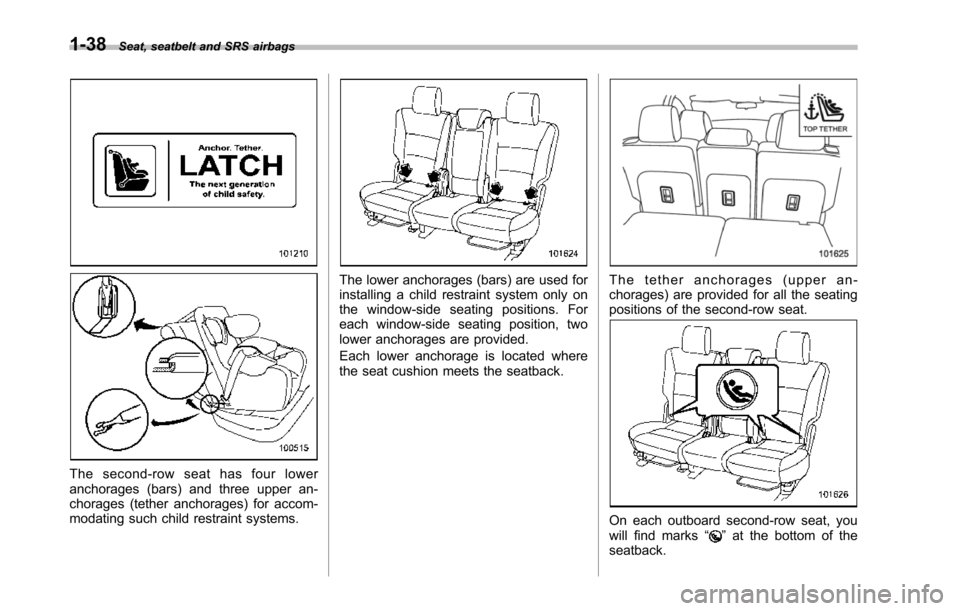
1-38Seat, seatbelt and SRS airbags
The second-row seat has four loweranchorages (bars) and three upper an-chorages (tether anchorages) for accom-modating such child restraint systems.
The lower anchorages (bars) are used forinstallinga child restraint system only onthe window-side seating positions. Foreach window-side seating position, twolower anchorages are provided.
Each lower anchorage is located wherethe seatcushion meets the seatback.
The tether anchorages (upper an-chorages)are provided for all the seatingpositions of the second-row seat.
On each outboard second-row seat, youwill find marks“”at the bottom of theseatback.